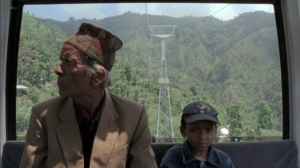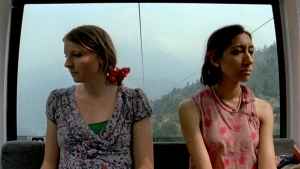Station to Station: Reflections on Manakamana
With Station to Station, recorded in 1975, David Bowie found himself in a state of transition. He was burnt out in America, riddled with drugs and paranoia, but he was also on the dawn of his return to Europe where he would cleanse and reinvent himself. His previous record was Young Americans, his appropriation of Philly soul music. His next would be Low, the start of his experimental Berlin trilogy. Station to Station falls in the middle, essentially representing the move from one side to the other, from past self to future, or as Bowie sings in the title track, “from Kether to Malkuth.”

Coincidentally, Station to Station could be an alternative title to Manakamana, the latest documentary from Stephanie Spray and Pacho Velez of Harvard’s Sensory Ethnography Lab. In this film, we take multiple rides in a cable car up and down the green Nepali hillside, to and from the Hindu temple from which the film takes its name. We move, quite literally, from station to station. Like Bowie, we spend most of our time in transition. We can even say that we are moving between Malkuth (the material world in the Kabbalistic tree of life) to Kether (the sublime “crown” of the tree of life, here represented by Manakamana itself).
As in Leviathan, the previous film from the Sensory Ethnography Lab, we are not given any information to help us contextualize what we are seeing in Manakamana. Instead, we are thrown directly into the experience. We begin in darkness, enveloped in the noise and humming of machinery. (Bowie’s “Station to Station” also begins with synthesized noises that mimic those of a moving train.) When we emerge into light, we find ourselves on the cable car, an old man and a young boy seated across from us. Behind them, we see the colorful hillside passing below us as we rise up the mountain. This landscape is mesmerizing, and it is easy to get lost in the gentle swaying branches of the trees. But it is equally likely to get lost in the faces. On this initial ride, the old man seems stoic. He glances around occasionally, as does the young boy, but neither reveals much about what he is thinking or why the pair are visiting the temple. When we finally reach the end of the ride at the uppermost station, we do not pause to take in the view or to explore our destination. Instead, we find ourselves once again in darkness. We hear people shuffling about, muffled voices, and some bleats of frightened animals. When we emerge again into daylight, the old man and the young boy have transformed into a woman (not a literal transformation, but a cinematic one).

In total, we take eleven cable car rides. Each transition is disorienting. Once we reach the top, we logically expect the next ride to be a downward one. However, we sometimes find ourselves back at the bottom, beginning an ascent. Also, we are sometimes facing backward, watching our point of origin diminish as we move away from it. Other times, we are facing forward, watching our destination appear closer and closer as we approach it slowly.
And each transformation is startling. We spend about nine minutes with each set of passengers (almost the length of “Station to Station”). In this time, we take what little information we can gather about the passengers, forge it with information we can provide from our own knowledge and past experiences, and try to craft some sort of satisfying narrative. Why is this person going to the temple? What is the nature of the relationship between these two individuals? Why does this person appear so sad? The most shocking transformation is one into goats, the cable car momentarily metamorphosed into an animal pen. With each transformation, we are further disoriented, and our half-spun narratives for previous passengers are forgotten so that we can begin crafting new ones.

This disorienting effect is interesting as a formal choice on the part of the filmmakers, but it also makes psychological sense. Each time we pass through a station, we may be under the spell of the “doorway effect.” The doorway effect is what researchers call the phenomenon of walking through a doorway and forgetting what we are doing and why we are doing it. In Manakamana, the doorway effect takes on an almost mystical dimension as we pass through a station, have our memories dissipate, and come face to face with new people (or animals), ready to receive them with a clean mental palette. Only once do we return to the same passengers, a couple who is making a pilgrimage to the temple with a live chicken. We check back in with them on their return, the chicken now dead.
We try desperately to empathize with all of these individuals, to discover what they are thinking and feeling, and to give them a story. Thus, as the passengers magically transform through the illusion of cinema, we also transform, switching perspectives from young to old, male to female, human to animal. The disorientation and the forgetting make our transformations smoother. We are better able to leave behind past selves to become someone new. It is a worthwhile exercise, and it makes Manakamana an unexpectedly aggressive and engaging work of art. We are not a mere audience watching this film from a safe distance; we, too, are passengers, participating, experiencing, and learning. We never make it to the temple per se, but we still come back transformed by it.
During the recording sessions for Young Americans, David Bowie recorded a song called “Who Can I Be Now?” By the time he recorded Station to Station, he was still asking this question. In fact, the question seems to have followed him throughout his entire career. He would often create a persona (such as Ziggy Stardust) only to retire it at the height of its success in order to try something new. Manakamana, by encouraging us to see the world through the eyes of so many disparate individuals, challenges us to live our own lives in the same manner. The more perspectives we entertain, the more complete a picture of life we will have drawn, from Malkuth to Kether and back again.
What do you think? Leave a comment.











I saw this documentary at TIFF and recommend it to everyone. Wonder when it has a wide release.
Documentary about a group of pilgrims who travel to Nepal to worship at the legendary Manakamana temple.How can it be bad!
An excellent article that gives some food for thought.